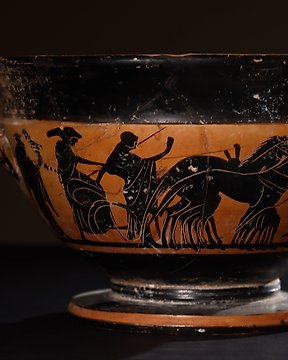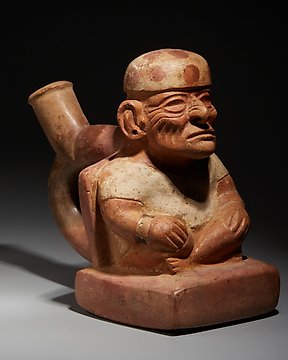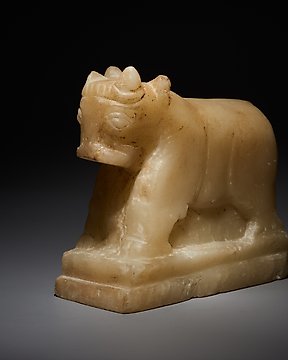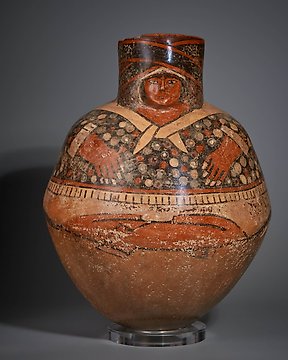All OK and with very fast shipping.
Übersetzung ansehenAltgriechisch Terracotta Schöne Tanagra-Figur Göttin Artemis mit einem Hirsch. 3. – 4. Jahrhundert v. Chr. 15,5 cm H. Ex.
Nr. 84871817
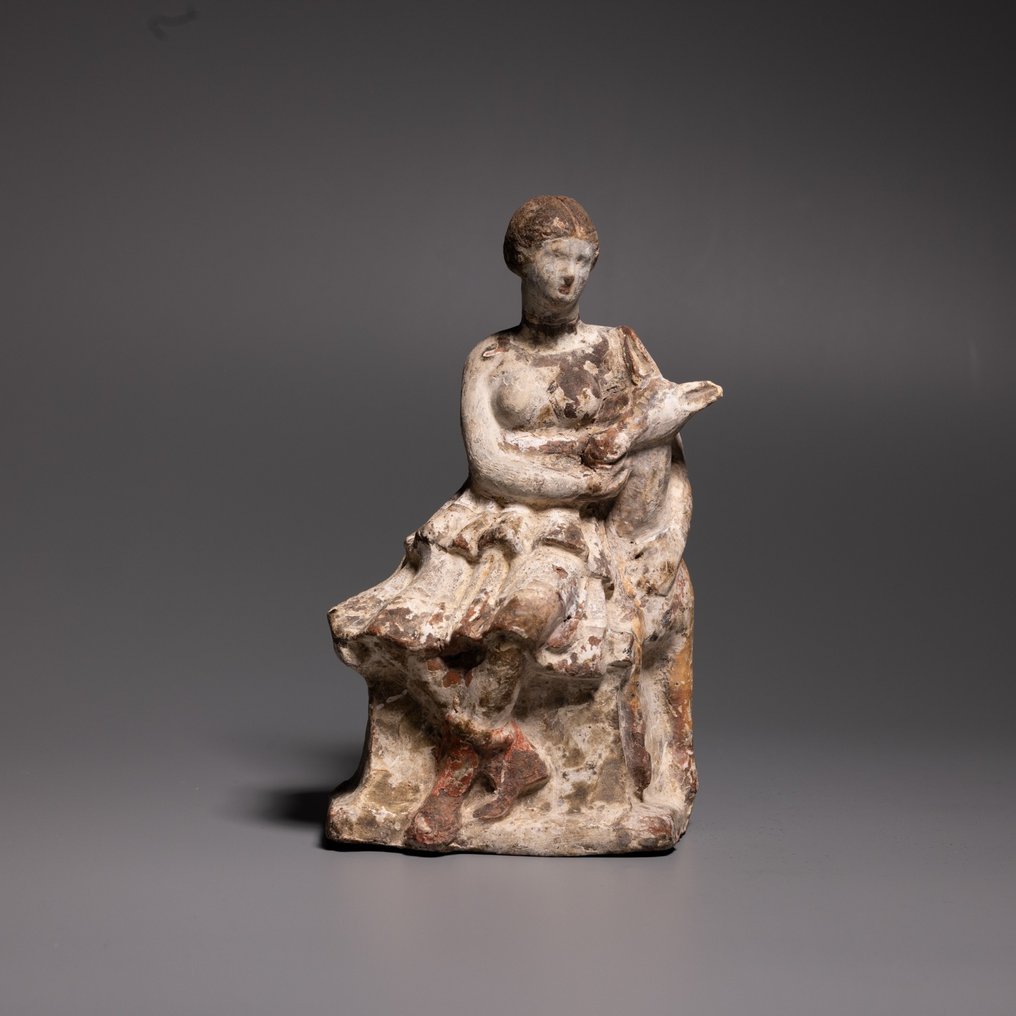
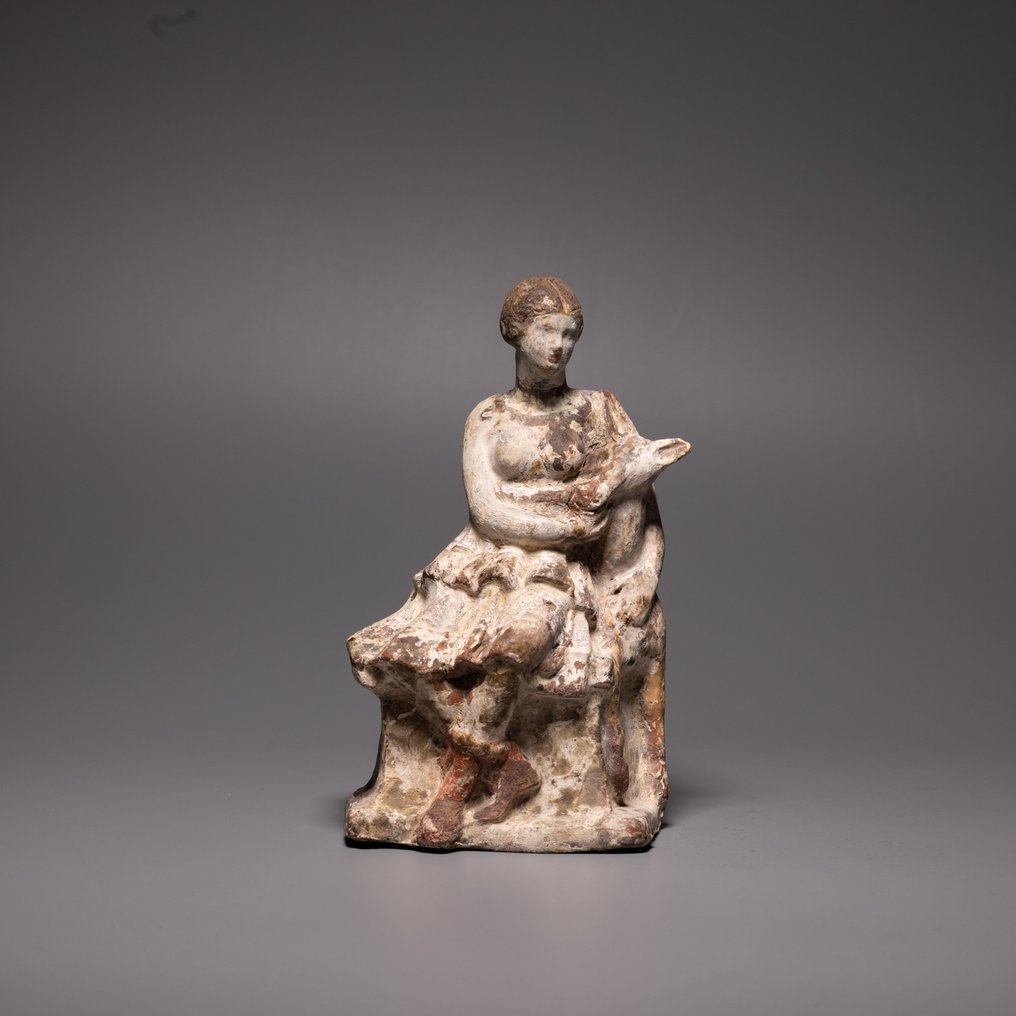

Female figure of Goddess Artemis with a deer
Greek, Tanagra, 3rd - 4th century BC
Terracotta
Height 15,5 cm
PROVENANCE: Private collection Mr. Schoulmers, Belgium. Acquired in Sotheby's, New York, 29 April 1999, lot 665.
CONDITION: Good condition.
DESCRIPTION:
Artemis, in Greek religion, the goddess of wild animals, the hunt, and vegetation and of chastity and childbirth; she was identified by the Romans with Diana. Artemis was the daughter of Zeus and Leto and the twin sister of Apollo. Among the rural populace, Artemis was the favourite goddess. Her character and function varied greatly from place to place, but, apparently, behind all forms lay the goddess of wild nature, who danced, usually accompanied by nymphs, in mountains, forests, and marshes. Artemis embodied the sportsman’s ideal, so besides killing game she also protected it, especially the young; this was the Homeric significance of the title Mistress of Animals.
The worship of Artemis probably flourished in Crete or on the Greek mainland in pre-Hellenic times. Many of Artemis’s local cults, however, preserved traces of other deities, often with Greek names, suggesting that, upon adopting her, the Greeks identified Artemis with nature divinities of their own. The virginal sister of Apollo is very different from the many-breasted Artemis of Ephesus, for example.
Dances of maidens representing tree nymphs (dryads) were especially common in Artemis’s worship as goddess of the tree cult, a role especially popular in the Peloponnese. Throughout the Peloponnese, bearing such epithets as Limnaea and Limnatis (Lady of the Lake), Artemis supervised waters and lush wild growth, attended by nymphs of wells and springs (naiads). In parts of the peninsula her dances were wild and lascivious.
Outside the Peloponnese, Artemis’s most familiar form was as Mistress of Animals. Poets and artists usually pictured her with the stag or hunting dog, but the cults showed considerable variety. For instance, the Tauropolia festival at Halae Araphenides in Attica honoured Artemis Tauropolos (Bull Goddess), who received a few drops of blood drawn by sword from a man’s neck.
The frequent stories of the love affairs of Artemis’s nymphs are supposed by some to have originally been told of the goddess herself. The poets after Homer, however, stressed Artemis’s chastity and her delight in the hunt, dancing and music, shadowy groves, and the cities of just men. The wrath of Artemis was proverbial, for to it myth attributed wild nature’s hostility to humans. Yet Greek sculpture avoided Artemis’s unpitying anger as a motif. In fact, the goddess herself did not become popular as a subject in the great sculptural schools until the relatively gentle 4th-century-BCE spirit prevailed.
At the end of the 4th Century BC a style of modeling clay called “Tanagra style” was developed. The name comes from the city of the same name, a center of production of terracotta figurines. The term alludes to a female figure, generally one standing, wearing a long draped chiton, over which was thrown a fine wide cloak. These women also often wore shoes, wide pointed hats and carried fans. They rarely carried other objects and in place of these, the arms and hands were wrapped in the cloak which could also be used to cover the head, and sometimes to almost completely cover the face.
NOTES:
This lot is Guaranteed to be Authentic and Genuine and will include a Certificate of Authenticity.
The seller can prove that the lot was obtained legally, provenance statement seen by Catawiki.
Important information. The seller guarantees that he is entitled to sell/export this lot.
The seller will take care that any necessary permits, like an export license will be arranged.
The seller will inform the buyer about the status of it if this takes more than a few days.
THE MINISTRY OF CULTURE FROM SPAIN ASKS ALL SELLERS FOR INVOICES OR OTHER DOCUMENTATION ABLE TO PROVE THE LEGALITY OF EACH ITEM BEFORE PROVIDING AN IMPORT OR EXPORT LICENSE.
#MorganNiquetCollection
Der Verkäufer stellt sich vor
Female figure of Goddess Artemis with a deer
Greek, Tanagra, 3rd - 4th century BC
Terracotta
Height 15,5 cm
PROVENANCE: Private collection Mr. Schoulmers, Belgium. Acquired in Sotheby's, New York, 29 April 1999, lot 665.
CONDITION: Good condition.
DESCRIPTION:
Artemis, in Greek religion, the goddess of wild animals, the hunt, and vegetation and of chastity and childbirth; she was identified by the Romans with Diana. Artemis was the daughter of Zeus and Leto and the twin sister of Apollo. Among the rural populace, Artemis was the favourite goddess. Her character and function varied greatly from place to place, but, apparently, behind all forms lay the goddess of wild nature, who danced, usually accompanied by nymphs, in mountains, forests, and marshes. Artemis embodied the sportsman’s ideal, so besides killing game she also protected it, especially the young; this was the Homeric significance of the title Mistress of Animals.
The worship of Artemis probably flourished in Crete or on the Greek mainland in pre-Hellenic times. Many of Artemis’s local cults, however, preserved traces of other deities, often with Greek names, suggesting that, upon adopting her, the Greeks identified Artemis with nature divinities of their own. The virginal sister of Apollo is very different from the many-breasted Artemis of Ephesus, for example.
Dances of maidens representing tree nymphs (dryads) were especially common in Artemis’s worship as goddess of the tree cult, a role especially popular in the Peloponnese. Throughout the Peloponnese, bearing such epithets as Limnaea and Limnatis (Lady of the Lake), Artemis supervised waters and lush wild growth, attended by nymphs of wells and springs (naiads). In parts of the peninsula her dances were wild and lascivious.
Outside the Peloponnese, Artemis’s most familiar form was as Mistress of Animals. Poets and artists usually pictured her with the stag or hunting dog, but the cults showed considerable variety. For instance, the Tauropolia festival at Halae Araphenides in Attica honoured Artemis Tauropolos (Bull Goddess), who received a few drops of blood drawn by sword from a man’s neck.
The frequent stories of the love affairs of Artemis’s nymphs are supposed by some to have originally been told of the goddess herself. The poets after Homer, however, stressed Artemis’s chastity and her delight in the hunt, dancing and music, shadowy groves, and the cities of just men. The wrath of Artemis was proverbial, for to it myth attributed wild nature’s hostility to humans. Yet Greek sculpture avoided Artemis’s unpitying anger as a motif. In fact, the goddess herself did not become popular as a subject in the great sculptural schools until the relatively gentle 4th-century-BCE spirit prevailed.
At the end of the 4th Century BC a style of modeling clay called “Tanagra style” was developed. The name comes from the city of the same name, a center of production of terracotta figurines. The term alludes to a female figure, generally one standing, wearing a long draped chiton, over which was thrown a fine wide cloak. These women also often wore shoes, wide pointed hats and carried fans. They rarely carried other objects and in place of these, the arms and hands were wrapped in the cloak which could also be used to cover the head, and sometimes to almost completely cover the face.
NOTES:
This lot is Guaranteed to be Authentic and Genuine and will include a Certificate of Authenticity.
The seller can prove that the lot was obtained legally, provenance statement seen by Catawiki.
Important information. The seller guarantees that he is entitled to sell/export this lot.
The seller will take care that any necessary permits, like an export license will be arranged.
The seller will inform the buyer about the status of it if this takes more than a few days.
THE MINISTRY OF CULTURE FROM SPAIN ASKS ALL SELLERS FOR INVOICES OR OTHER DOCUMENTATION ABLE TO PROVE THE LEGALITY OF EACH ITEM BEFORE PROVIDING AN IMPORT OR EXPORT LICENSE.
#MorganNiquetCollection
Der Verkäufer stellt sich vor
- 754
- 6
- 0
Prachtig schilderij. Zo blij mee. Zeer nette verkoper en zeer snelle levering.
Übersetzung ansehenperfect ! very fast and high quality delivery !
Übersetzung ansehenAll well! Thanks.
Übersetzung ansehenVendeur très professionnel, top +++×
Übersetzung ansehenPhotos trop contrastées pour bien percevoir les défauts, mais ces défauts étaient visibles pour autant. Le "Bon état" est trompeur. Sinon, envoi rapide et correctement emballé. Frais de port exagérés.
Übersetzung ansehenGreat communication, delivery and product. Came with a well made certificate of authenticity and good packaging. Overall very happy with the purchase! Delivery is a bit expensive, but I recommend it
Übersetzung ansehenMagnifique témoin du passé, envoyé avec tous les justificatifs, impeccable. Encore une fois très satisfait, un grand merci
Übersetzung ansehenThank you for the Special offer and the fast shipping of this excellent piece of art!
Übersetzung ansehenvery good description of the object, very good price for this rare item,. Fast sending (has been at my place 2 days after buying!). Definitely would buy again.
Übersetzung ansehenSehr schön
Übersetzung ansehenAs described, perfect logistic
Übersetzung ansehengreat seller, everything came as should with certificate of authenticity
Übersetzung ansehenExceptionally well packaged, description aligned with positing received
Übersetzung ansehenReally precious, but without sound...
Übersetzung ansehenPainting well packed and rapidly sent!
Übersetzung ansehensempre grande rapidità e professionalità
Übersetzung ansehenparfait bien reçu, merci
Übersetzung ansehenVery satisfied with the small Greek Lekythos. As always (we have already bought several items from Bagot), the object was wrapped and sent immediately and with the greatest care.
Übersetzung ansehenPerfect, excellent condition, good packaging, the parcel arrived without any problems… all is perfect as usual. Thank you very much and wait for an other nice piece like this one. Gilles.
Übersetzung ansehen+++ Top vendeur professionnel comme d'habitude
Übersetzung ansehenEmbora o custo de transporte esteja acima da média foi, realmente, muito bem executado e em embalagem cuidada. Expeditos e profissionais. Recomendo
Übersetzung ansehenSnel en correct en goed verpakt verzonden
Übersetzung ansehenoggetto bellissimo, fedele alla descrizione, venditore affidabile
Übersetzung ansehenVery nice piece and fast delivery
Übersetzung ansehen- 754
- 6
- 0
All OK and with very fast shipping.
Übersetzung ansehenDisclaimer
Der Verkäufer garantiert und kann belegen, dass das Objekt legal erworben wurde. Der Verkäufer wurde von Catawiki darüber informiert, dass er die Unterlagen, die gemäß den Gesetzen und Vorschriften seines Landes erforderlich sind, zur Verfügung stellen muss. Der Verkäufer garantiert, dass er berechtigt ist, das Objekt zu verkaufen/auszuführen. Der Verkäufer wird dem Käufer alle Informationen, die zur Provenienz des Objekts vorliegen, zur Verfügung stellen. Der Verkäufer versichert, dass alle erforderlichen Genehmigungen eingeholt wurden/werden. Der Verkäufer wird den Käufer unverzüglich über etwaige Verzögerungen bei der Einholung dieser Genehmigungen informieren.
Der Verkäufer garantiert und kann belegen, dass das Objekt legal erworben wurde. Der Verkäufer wurde von Catawiki darüber informiert, dass er die Unterlagen, die gemäß den Gesetzen und Vorschriften seines Landes erforderlich sind, zur Verfügung stellen muss. Der Verkäufer garantiert, dass er berechtigt ist, das Objekt zu verkaufen/auszuführen. Der Verkäufer wird dem Käufer alle Informationen, die zur Provenienz des Objekts vorliegen, zur Verfügung stellen. Der Verkäufer versichert, dass alle erforderlichen Genehmigungen eingeholt wurden/werden. Der Verkäufer wird den Käufer unverzüglich über etwaige Verzögerungen bei der Einholung dieser Genehmigungen informieren.





